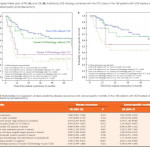Editorial: Biomarkers for UCPPS: is there light at the end of the tunnel?
Management of urological disease begins with an accurate diagnosis. For this purpose, urologists have PSA and biopsy for prostate cancer, bacterial culture for UTI, CT scan for urolithiasis, cytology, cystoscopy and biopsies for bladder cancer, semen analysis for infertility and the list goes on. We have been able to use these accurate diagnostic markers to kill, maim, remove, fragment or burn our way to therapeutic success. Unfortunately, this has not been true in the case of urological chronic pelvic pain syndrome (UCPPS), where specific diagnoses and therapeutic strategies continue to elude us. Urologists managing patients with UCPPS need something concrete and quantifiable to move the field and improve patient care. A validated and reliable biomarker might fit the bill.
As Dagher et al. [1] clearly show in their study, this is not going to be as easy as we had hoped. The research group analysed urine samples for candidate biological markers from both patients with UCPPS and healthy controls recruited for the Multidisciplinary Approach to the Study of Chronic Pelvic Pain (MAPP) Research Network. The National Institutes of Health/National Institute of Diabetes and Digestive and Kidney Diseases (NIH/NIDDK) developed the MAPP Research Network to provide a comprehensive, multidisciplinary research approach for UCPPS [2, 3]. A major goal of this novel initiative is to better understand UCPPS pathophysiology allowing improved diagnoses and patient stratification that informs identification of therapeutic targets and ultimately improves clinical management.
In the present study, candidate biomarkers were initially selected based on their proposed involvement in underlying processes implicated in UCPPS. The authors showed marginal biomarker discrimination between patients with UCPPS and healthy control subjects. Furthermore, they observed provocative biomarker patterns correlating with pain and urinary symptom severity. None of these observations were conclusive enough, however, to allow a clinically applicable differentiation between patients with UCPPS and control subjects with no UCPPS symptoms. The patterns associated with pain and urinary severity were also not sufficiently robust to provide clinical direction. The underlying reason for these results is probably related to our recent understanding that UCPPS is not a clearly defined disease, but rather a complicated syndrome consisting of a confusing myriad of clinical conditions involving the bladder, prostate and/or pelvic floor and probably systemic contributions from other systems, including the nervous system. Indeed, the chronic pelvic pain and urinary symptoms appear as a result of interrelated, but variable, pathophysiology incorporating inflammatory, microbial, endocrine, neuromuscular, peripheral and CNS and even psychological pathways. The systemic characterization of UCPPS in the MAPP Network supports the idea that each patient with a UCPPS diagnosis represents an individual clinical picture and symptom profile. The promise of well-powered and carefully controlled biomarker research, such as described in the present study, will probably be realized when fully integrated into a systemic clinical profile using phenotypic insights (biological and symptom) still evolving from the MAPP Network and other studies. This is expected to yield a better understanding of specific mechanisms and symptom profiles operative in individual patients or patient subgroups. Identification of biomarker patterns that inform the clinical picture has the promise to allow us, in future, to make individualized diagnoses leading to individualized mechanistically (not only phenotypically) directed prognostic and therapeutic strategies. Success in such efforts will lead to UCPPS becoming less of a urological mystery. Then this enigmatic condition might join other urological diseases for which we have accurate diagnostic algorithms and successful therapeutic interventions.
The ongoing MAPP-2 Research Network’s Symptom Patterns Study is using state-of-the-art approaches to examine closely the interrelationships between the inflammatory, endocrine, microbial, neurological and psychological systems and how these interactions influence patients’ symptoms over a 2–3-year time period. This includes correlations with diverse biological markers over time. It is hoped that MAPP-2 will unravel the tangled web of these mechanistic pathways, allowing better diagnosis and ultimately, better therapy for our patients with UCPPS. That is our promise of the light at the end of a very long urological tunnel.



